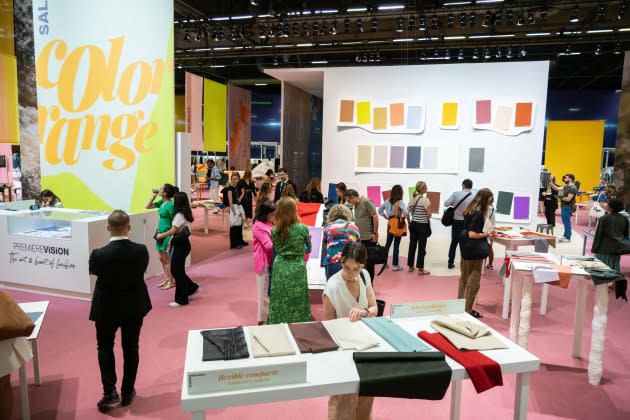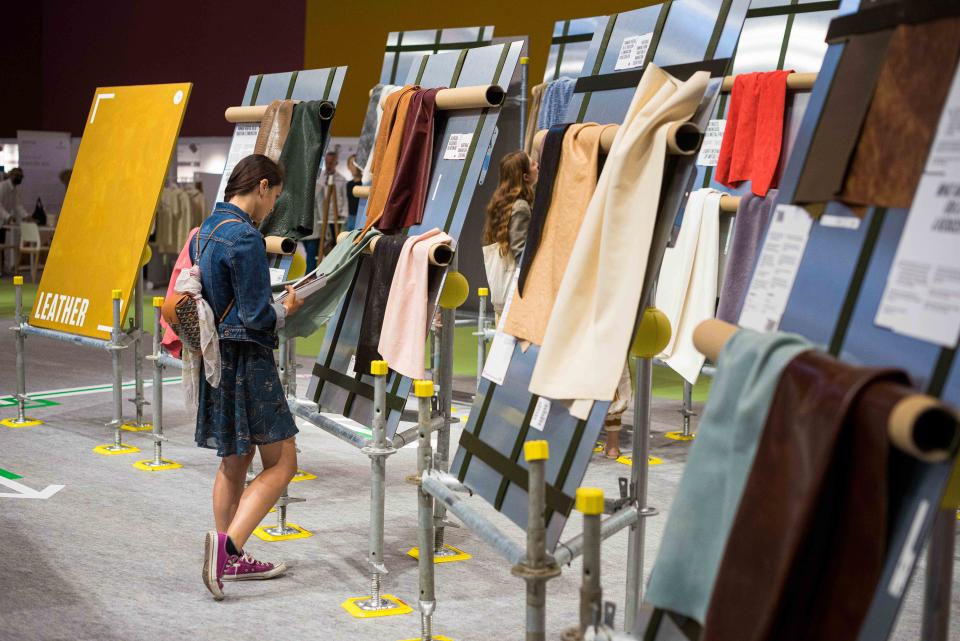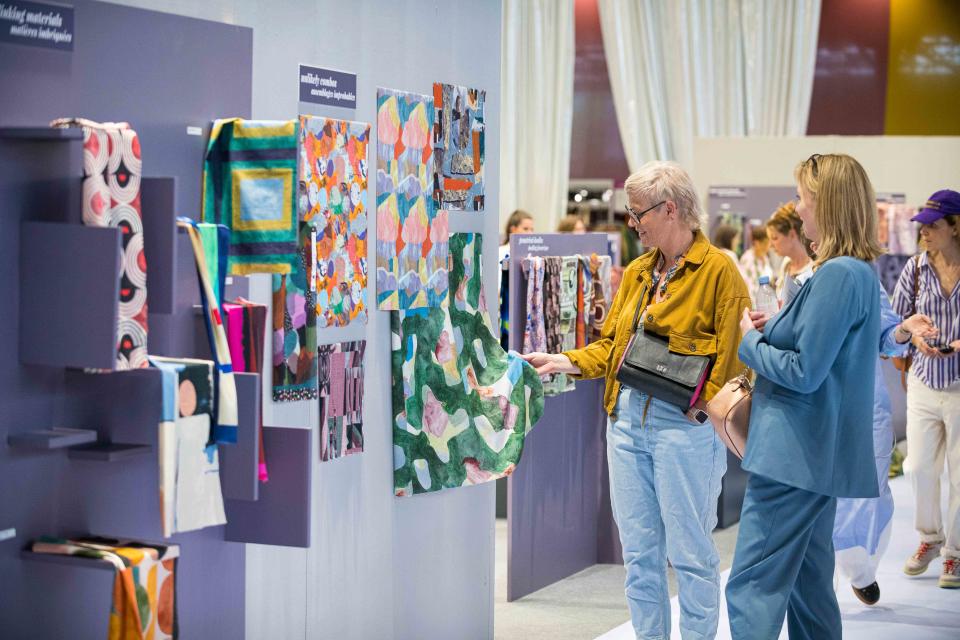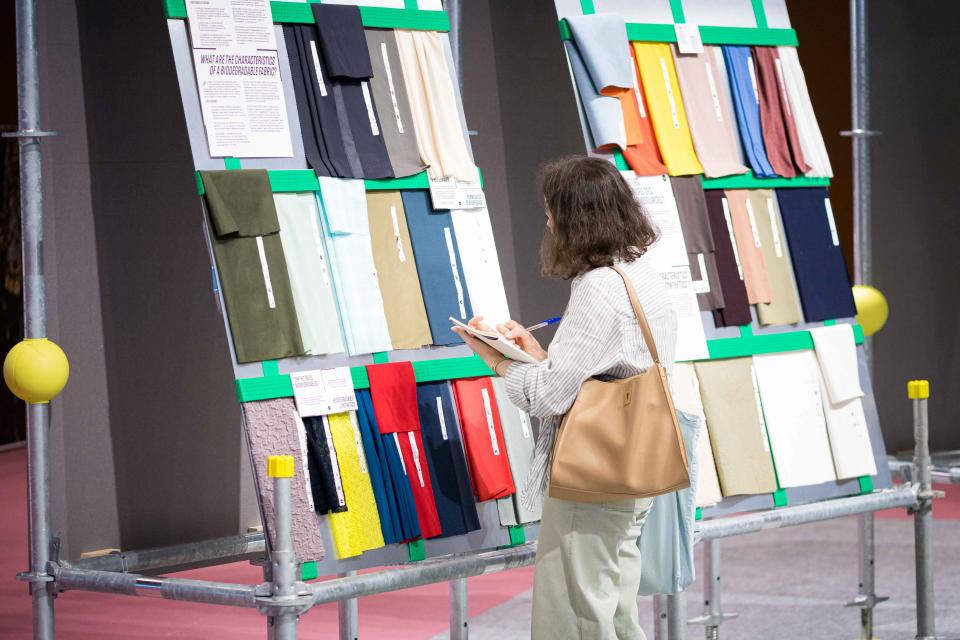Première Vision’s July Move a Hit, With 10 Percent More Visitors Versus February

PARIS — Held from July 5 to 7 in a brief pause from record temperatures hitting France once again, Première Vision’s physical fall-winter 2023-2024 show marked industrywide acceleration and cooperation in addressing climate impact in the fashion supply chain.
Meanwhile, designers applauded the global textiles fair’s major calendar change to July from September.
More from WWD
“It’s better for our timeline, it works out better for production and for early forecasting,” said Amanda Goss, senior designer at The North Face.
“September was impossible — lead times are much longer now, so July is much better for our sourcing,” agreed Jane Seim, creative director and founder of skiwear label Cordova.
Even menswear designers, with little break from showing to starting the next collection, lauded the switch. “I held my show two weeks ago, so that’s close but at the same time, it’s a chance to begin again quickly, so that’s an advantage,” said Walter Van Beirendonck.
“This show is brilliant in July. We’ve been able to combine winter ‘23, spring ‘24 and winter ’24, so we’re doing three seasons here,” agreed menswear designer Nigel Cabourn. “We’re doing three collaborations on top of our own product, so we have to look at a lot of fabrics, so the fact that it’s two months earlier is better.”
Cabourn named fleeces at Texapel and Riccardo Bruni’s designs for Lyria among his standout collections.
“The collections are ready, which was the most challenging point to switch from mid-September to early July,” said Première Vision chief executive officer Gilles Lasbordes.
Despite being held between two airport strikes, with a city transport strike during its second day, 23,377 fashion professionals visited the show, up 10 percent versus February, with double that number logging on to the digital marketplace.
Browsing almost 1,200 exhibitors, up by a third from the September 2021 show, 69 percent of design teams were international, with a marked return of U.S. and South Korean visitors. Brands and exhibitors from China, Hong Kong and Taiwan remained absent due to quarantine rules.
In a context where global warming is already impacting supply — intense droughts have damaged cotton crops in both the U.S. and India this year — the global textile fair made environmental performance a priority, with a new Eco Innovations Forum adjacent to its Smart Creation section.

Alex Gallosi/Courtest of Premiè
“We’re working to help brands to make better choices in their supply chain,” said Lasbordes, noting the introduction of guided visits to help brands navigate the Eco Innovations Forum. “While larger fashion groups have dedicated teams and engineers to pilot approaches to meeting their sustainability commitments, smaller brands essentially have to gain an understanding of engineering to handle the issues at stake in the supply chain,” he said.
With physical presentations of the fabrics, breaking down criteria for each material, across recycling, natural dyeing, biopolymers, biodegradability and more, the zone was among the buzziest for designers with sustainability targets in mind.
“By 2025, we’re supposed to be 100 percent sustainable materials, so that’s a number-one focus for us, and as an activewear brand there’s the additional criteria of performance,” said Marisa Ripo, global design director at The North Face, which defines sustainably sourced materials as recycled, regenerative or responsibly sourced renewable fabrics. “We’re obsessed with anything mycelium, fungi, algae, anything that grows quickly,” added Goss.
Among smaller brands browsing the zone, Chloe Denis, technical designer for Danish menswear label Iso.Poetism by Tobias Birk Nielsen, mused that technology seems to still outpace environmental considerations.
“We can see there’s more sustainability even though it’s going slowly, and the fabrics are still expensive. And the most interesting fabrics in terms of texture are not recycled,” she said. Denis named Seaqual’s DNA traceability, from recycled ocean plastic to yarn to apparel, as a standout.
With supply chain tracking a key requisite in upcoming environmental standards legislation, four of the five new exhibitors in the Smart Creation section offered traceability solutions, using blockchain, as at Dutch start-up Aware or French company Crystalchain, or tracing leather by lasering ID numbers from each animal’s individual tag into the hide as at Spoor, a Danish tannery.
As well as becoming legally binding, such accountability is critical to consumer purchasing, according to the 7,000-consumer, five-country study that Première Vision published on its first day.
The research, led by the Institut Français de La Mode, revealed a significant jump in “eco responsible” fashion buying over the past three years: to 65 percent in 2022 in France from 45 percent in 2019, for example, rising to 78 percent among Italians, versus 45 percent in 2019.

Alex Gallosi/Courtest of Premiè
A key takeaway from the report, also conducted in Germany, the U.K. and the U.S., is that among consumers who had not bought a purported “eco fashion” item in the past year, 65 percent of respondents in France and 49 percent of U.S. shoppers said they were held back by a lack of information.
“So the reason why they didn’t buy an eco responsible product, it’s not price, it’s not style, the major obstacle is ‘lack of information,’” Lasbordes explained. “They don’t know the labels, even the major ones, GOTS, Oeko-Tex, they just don’t know them. There’s work to be done to educate consumers. They don’t feel informed and then they fear greenwashing.”
With environmental ratings for textiles due to become mandatory in France in 2023, and Europe-wide by 2026, that is set to change. Coordinating the pilot phase for a similar scoring system as that used on household appliances, Pascal Dagras, environmental labelling project manager at Ecobalyse for the French Ministry in charge of Ecological Transition, urged industry players to participate in defining the impact methodology used, among 11 being piloted.
“This is a beta tool, tell us what does and doesn’t make sense based on your understanding of the industry,” he said during the show’s talk sessions.
New York’s proposed Fashion Act, yet to be voted on, will similarly level the playing field. Speaking to the Première Vision audience via video link, Maxime Bédat of The New Standard Institute said: “’Sustainability’ is a word that’s suffered from greenwashing the most. And the most problematic part is that it’s been used to sell more product. That’s not a framework that the planet and the people on the planet need to make the progress we need to make.”
Once passed, the Fashion Act would legislate for concrete disclosures on science-based climate benchmarks, considering both volumes and types of material used, chemicals used plus human protection so anyone harmed in the supply chain can seek justice.
One major hurdle is that sustainability teams previously had to defend to their finance heads that their work was somehow improving the bottom line, Bédat explained. “That’s not the work of the sustainability team, that somehow this will improve sales. The work of the sustainability team is, ‘We’re reducing our impact in line with planetary bounds,’” she said.
With environmental standards also calling for product lifecycle accountability, winter 2023-24 featured many more biodegradability claims for textiles. “We’re seeing a wider selection of both recycled and biodegradable fabrics, lots of development in that space, more options compared to previous seasons,” said Seim, naming new textured fabrics featuring membrane technology for waterproofing at Mectex among her highlights.
New fabrics on offer with biodegradability claims included lace by Swiss embroidery-maker Bischoff or Gacha, a velvet-like fabric at fake fur maker Ecopel, made of Celys, a purported biodegradable polyester.

Alex Gallosi/Courtest of Premiè
“It can seem a total paradox between a product having a long lifecycle but then not impacting on landfill,” said Arnaud Brunois, sustainable development and communications director at Ecopel. “Biodegradability shouldn’t encourage disposable culture. A textile breaks down in specific conditions according to heat and humidity.”
Among newcomers drawing visits from big name designers was Stratasys, whose new 3D printer for fabric, which creates a lens-like visual effect on the fabric, was unveiled at Milan Design Week. “Designers are always looking for a new look, different fusions and materials, and we say if you can design it, we can print it,” said Stratasys application development expert Boris Belocon.
Outlining winter 2023-24 color trends, Première Vision’s fashion director Desolina Suter noted a move toward the natural color of fibers themselves. “You capitalize on the original color of the animal’s wool, so it’s a way to produce without dyeing,” she said.
Meanwhile, natural dyes, such as vegetable dyes from the food chain, are being pushed to produce more intense colors that can be used on a greater variety of materials, achieving bolder colors from foods like pomegranate, say, or leather dyed with waste from wine production, as at Ictyos, a French company making leather from fish industry waste.
Winter 2023-24 also provided an expanded offer of circular, zero waste approaches, such as at Manteco, a mill in Italy’s historic Prato region, which simply reproduces colors using the original colors of the surplus clothes being recycled. “The color feels really exciting and fresh, really happy,” said The North Face’s Ripo of the overall season.
To help design teams complete their fall collections, Première Vision is holding a complement to the July edition, a scaled-down September show of around 200 exhibitors at the Carreau du Temple on Sept. 7 and 8.
Sign up for WWD's Newsletter. For the latest news, follow us on Twitter, Facebook, and Instagram.


